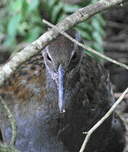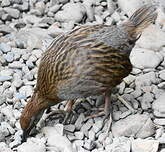Weka
Gallirallus australis - Râle wéka
Identification
The Weka is a large, flightless bird (bigger than a Coot). Its overall colour is mostly light brown, depending on the subspecies. The upperparts are irregularly marked with darker brown and the darkest (australis) lives in the south-west and north-west of the south island, the lightest (hectori) was introduced to Chatham Island. There is a vague light eyebrow. The beak is pointed, of a light coloured horn with a dark tip, not particularly long in relation to the size of the bird. The legs are light to medium brown, and the juveniles are usually more plain.
Subspecific information 4 subspecies
- Gallirallus australis australis (n and w South I.)
- Gallirallus australis greyi (North I.)
- Gallirallus australis hectori (e South I., Chatham Is.)
- Gallirallus australis scotti (Stewart, Solander and Codfish Is.)
Foreign names
Voice song and call
Habitat
Behaviour character trait
The Weka is both discreet and curious. Not easy to observe in the forests where it looks for food under the vegetation, but very confident, even when accompanied by a chick.
I have had several opportunities to see these birds feed at my feet, seeming to totally ignore me ... Unable to fly, it moves quickly. When it feels threatened, it bobs its tail in jerks. The main periods of activity are at the end of the day, but the species is active both day and night. At night, it prefers to sleep in a hole, under rocks or in a burrow, during the day, rather in bushes. These are monogamous birds that remain united for life (we know a case of 13 years!) And that occupy their territory all year round. The size of this territory varies from 3 to 15 ha according to the quality of the environment and the number of couples present. It sometimes happens that a single male lives with two females and even that two females live together. We can sometimes observe gatherings when an important source of food is found.Dietfeeding habits
The Weka actively searches for its food. I have had several opportunities to observe it, both in the forest and on the beaches.
With its beak, it flips over small pebbles, piles of seaweed or dead leaves under which it looks for small invertebrates. I have also seen it relentlessly trying to break into a banana forgotten by a walker. In a few vigorous pecks, he was able to pierce the skin and then eat the pulp: in ten minutes, it had consumed half of it, while the large young one accompanying it was equally eating it. In fact, the species is an opportunistic omnivore. It even has a tendency to eat eggs of other species such as the rare Fiordland Penguin (Eudyptes pachyrhynchus). This leads to the paradox that this threatened species cannot be introduced to the islands where species such as the Takahé live. This even causes us to move Weka which had been introduced on some of these islands.Reproduction nesting
The breeding season extends from November to February. The laying date varies a lot depending on the climate, available food and even the population size in a site.
In regions where the population is expanding, there can be laying throughout the year, with one female capable of having up to four. The nest is a cup of grass. It seems that only the male builds it. There are several nest sites on the same territory, with the birds using one or the other at times. The size of the laying varies from 1 to 6 eggs (usually from 2 to 4) incubated for approximately 4 weeks by the female during the day and the male during the night. The eggs are laid with an interval of two days or more. Incubation often begins with the first egg, which makes the hatching very dispersed. The chicks are nidifugous but they can be fed by the parents for a long time (up to more than 3 months). The young are chased away from the territory before the next laying.Threats - protection
IUCN conservation status
concern
in the Wild
threatened
evaluated
Weka is classified as vulnerable by BirdLife International. The population living in the north-east of the North Island (greyi subspecies) has lost 90% of its population since the early 1980s. The hectori subspecies has been introduced to Chatham Island in order to avoid its total extinction. As for the scotti subspecies, it has been released on several islands near Stewart Island (whose population had gone extinct in the early 1990s). These island populations have particularly developed well, so birds have recently been reintroduced to Stewart Island. Even the populations of the South Island (which belong to the nominal subspecies) are decreasing sharply. Therefore, we have populations that we will call 'natural' that are in sharp decline and populations that have been introduced to dozens of islands that are expanding. By the end of the 20th century, the total population was between 100,000 and 150,000 individuals. The causes of the decrease are numerous. As with other species that have become rare in New Zealand, the introduction of predators is one of the main ones. We can add to that the deterioration of habitats, deaths due to road traffic and... one more paradox, poisonings by bait intended for predators that threaten this species and others !! Nothing is simple in the fight for survival...
Sources of information
- IOC World Bird List (v14.2), Gill, F and D Donsker (Eds). 2024-04-18.
Other sources of interest
 Specification sheet created on
30/07/2023 by Georges Olioso
Specification sheet created on
30/07/2023 by Georges OliosoTranslation by AI Oiseaux.net
© 1996-2025 Oiseaux.net
- Accipitriformes
- Aegotheliformes
- Anseriformes
- Apodiformes
- Apterygiformes
- Bucerotiformes
- Caprimulgiformes
- Cariamiformes
- Casuariiformes
- Charadriiformes
- Ciconiiformes
- Coliiformes
- Columbiformes
- Coraciiformes
- Cuculiformes
- Eurypygiformes
- Falconiformes
- Galliformes
- Gaviiformes
- Gruiformes
- Leptosomiformes
- Mesitornithiformes
- Musophagiformes
- Nyctibiiformes
- Opisthocomiformes
- Otidiformes
- Passeriformes
- Pelecaniformes
- Phaethontiformes
- Phoenicopteriformes
- Piciformes
- Podargiformes
- Podicipediformes
- Procellariiformes
- Psittaciformes
- Pterocliformes
- Rheiformes
- Sphenisciformes
- Steatornithiformes
- Strigiformes
- Struthioniformes
- Suliformes
- Tinamiformes
- Trogoniformes




























